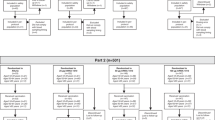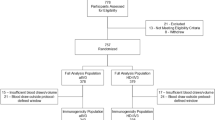Abstract
Background
The trivalent inactivated split-influenza vaccine, Fluarix™, has been available since 1992.
Aim
To assess the safety and immunogenicity of the vaccine from studies in healthy adults and the elderly performed from 1992 to 2001 to comply with European Union registration requirements, and from studies in children and populations at high risk of severe influenza illness or influenza-related complications.
Methods
Annual registration studies were performed in healthy adults aged 18–60 years and the elderly aged >60 years. Six studies in children aged 6 months-18 years, and five studies in adults with high-risk conditions, were done during the same period. The high-risk populations included immunosuppressed patients with solid tumours or systemic malignancies, renal or liver transplant recipients, and patients with chronic obstructive pulmonary disease or insulin-dependent diabetes mellitus. Adults and children aged >36 months received 0.5ml of the vaccine by intramuscular or deep subcutaneous injection. Children aged 6–35 months received 0.25ml; in some children not previously vaccinated or exposed to influenza, a second dose was given 4 weeks later. Immunogenicity was determined by measuring haemagglutination inhibiting antibodies just before and 21 ± 2 days after vaccination. Redness, swelling, induration and pain at the injection site were recorded, along with systemic symptoms such as fever.
Results
In all registration studies (n = 1 558), the vaccine consistently exceeded European Union immunogenicity criteria. Geometric mean titres in adults peaked 21 days after vaccination and remained above the protection level for all three strains for up to 12 months. In healthy adults and the elderly, seroprotection rates were 69–100% and consistently exceeded 82% from 1996. Immunogenicity in children (n = 364) and high-risk populations (n = 285) exceeded the targets for healthy adults. The vaccine was well tolerated in all age groups and populations. The most frequently reported symptoms in healthy adults and the elderly were local redness of >20mm (10–31%) and swelling of >20mm (11–16%). The incidence of fever >38.5°C was <-4% in healthy adults and high-risk groups; fever of >37°C was also rare (0–5%) in children over 6 years old, but was more frequent in younger children (11–27%). The reactogenicity of the vaccine was low in the high-risk populations.
Conclusions
Fluarix™ has a good safety profile and is highly immunogenic in all age groups as well as in high-risk populations. The all-year persistence of antibodies means that the vaccine gives protection for the entire influenza season.



















Similar content being viewed by others
Notes
1Use of tradenames is for product identification only and does not imply endorsement.
References
Patriarca PA, Strikas RA. Influenza vaccine for healthy adults? N Engl J Med 1995 Oct 5; 333(14): 933–4
Potter CW. Chronicle of influenza pandemics. In: Nicholson KG, Webster RG, Hay AJ, editors. Textbook of influenza. Oxford: Blackwell Science, 1998: 3–18
World Health Organization. Influenza. WHO Information, Fact Sheet No 211 1999
Nicholson KG. Human influenza. In: Nicholson KG, Webster RG, Hay AJ, editors. Textbook of influenza. Oxford: Black-well Science, 1998: 219–264
Glezen WP, Decker M, Perrotta DM. Survey of underlying conditions of persons hospitalized with acute respiratory disease during influenza epidemics in Houston, 1978–1981. Am Rev Respir Dis 1987 Sep; 136(3): 550–5
Barker WH, Mullooly JP. Pneumonia and influenza deaths during epidemics: implications for prevention. Arch Intern Med 1982 Jan; 142(1): 85–9
Lui KJ, Kendal AP. Impact of influenza epidemics on mortality in the United States from October 1972 to May 1985. Am J Public Health 1987 Jun; 77(6): 712–6
Ashley J, Smith T, Dunell K. Deaths in Great Britain associated with the influenza epidemic of 1989/90. Pop Trends 1991; 65: 16–20
Centers for Disease Control and Prevention. Prevention and control of influenza: recommendations of the Advisory Committee on Immunization Practices (ACIP). MMWR Recomm Rep 2002 Apr 12; 51(RR-3): 1–31
Commission of the European Communities. Ad hoc working party on biotechnology/pharmacy ‘Harmonisation of requirements for influenza vaccines’ III/3188/91-EN. 1991
Committee for Proprietary Medicinal Products (CPMP). Note for guidance on harmonisation of requirements for influenza vaccines CPMP/BWP/214/96. London: The European Agency for the Evaluation of Medicinal Products, 1997
US Department of Health and Human Services. Influenza virus reagents for the hemagglutination test. Atlanta (USA): Centers for Disease Control and Prevention. Technical Service Branch, 1991
Hobson D, Baker FA, Curry RL. Effect of influenza vaccines in stimulating antibody in volunteers with prior immunity. Lancet 1973 Jul 21; II(7821): 155–6
Künzel W, Glathe H, Engelmann H, et al. Kinetics of humoral antibody response to trivalent inactivated split influenza vaccine in subjects previously vaccinated or vaccinated for the first time. Vaccine 1996 Aug; 14(12): 1108–10
Van Hoecke C, Prikazsky V, Ütö I, et al. Immunogenicity of an inactivated split influenza vaccine in institutionalized elderly patients. Gerontology 1996; 42(4): 190–8
Künzel W, Engelmann H, D’Hondt E. Immune response to influenza vaccination [letter]. Lancet 1994 Jan 15; 343(8890): 173
Groothuis JR, Levin MJ, Rabalais GP, et al. Immunization of high-risk infants younger than 18 months of age with split-product influenza vaccine. Pediatrics 1991 Jun; 87(6): 823–8
Iorio AM, Zei T, Neri M, et al. Immunization of elderly volunteers with the 1988–89 inactivated whole influenza vaccine: assessment of antibody responses by haemagglutination inhibition and single radial haemolysis tests. Eur J Epidemiol 1992 Jul; 8(4): 491–7
Glathe H, Bigl S, Grosche A. Comparison of humoral immune responses to trivalent influenza split vaccine in young, middle-aged and elderly people. Vaccine 1993; 11(7): 702–5
Van Hoecke C, Raue W, Künzel W, et al. Immunogenicity and safety of influenza vaccination in 3- to 6-year-old children with a two dose immunisation schedule. Eur J Pediatr 1996 Apr; 155(4): 346–7
Brydak LB, Machala M. Humoral immune response to influenza vaccination in patients from high risk groups. Drugs 2000 Jul; 60(1): 35–53
Kanakoudi-Tsakalidou F, Trachana M, Pratsidou-Gertsi P, et al. Influenza vaccination in children with chronic rheumatic diseases and long-term immunosuppressive therapy. Clin Exp Rheumatol 2001 Sep–Oct; 19(5): 589–94
Brydak LB, Calbecka M. Immunogenicity of influenza vaccine in patients with hemato-oncological disorders. Leuk Lymphoma 1999 Jan; 32(3–4): 369–74
el-Madhun AS, Cox RJ, Seime A, et al. Systemic and local immune responses after parenteral influenza vaccination in juvenile diabetic patients and healthy controls: results from a pilot study. Vaccine 1998 Jan–Feb; 16(2–3): 156–60
Acknowledgements
All the clinical studies reported were funded by SmithKline Beecham Biologicals (now known as GlaxoSmithKline Biologicals), Rixensart, Belgium.
Author information
Authors and Affiliations
Corresponding author
Rights and permissions
About this article
Cite this article
Hehme, N.W., Künzel, W., Petschke, F. et al. Ten Years of Experience with the Trivalent Split-Influenza Vaccine, Fluarix™. Clin. Drug Investig. 22, 751–769 (2002). https://doi.org/10.2165/00044011-200222110-00004
Published:
Issue Date:
DOI: https://doi.org/10.2165/00044011-200222110-00004




